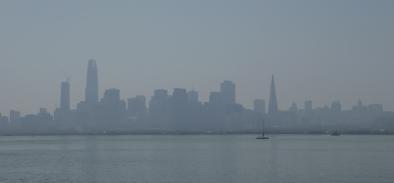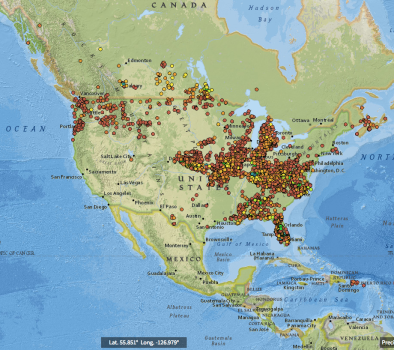California Statewide Heat Wave September 2017
"The greatest statewide heat wave ever recorded in California"[1] began in late August and lasted through early September, as a major high pressure system stalled over the western United States. Many locations broke daily, monthly, and all time temperature records.[2] Most notably, San Francisco broke its all time heat record, reaching 106°F on September 1.[3]
Record breaking heat waves are a classic signal of climate change. The trend in global warming has contributed to the severity and probability of 82 percent of record-hot days globally over the 1961-2010 period.[4]
The heat wave bears several signatures of heat waves on a warming planet: record-breaking heat, hot nights, high humidity, long duration, and increasing frequency.
This heat wave comes on the heels of June’s heat wave, which also broke temperatures records across the state.


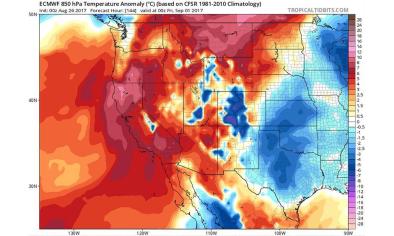
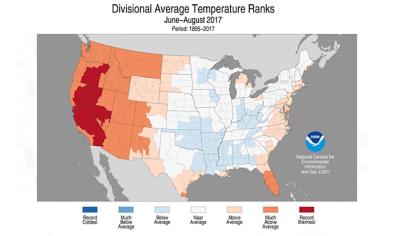
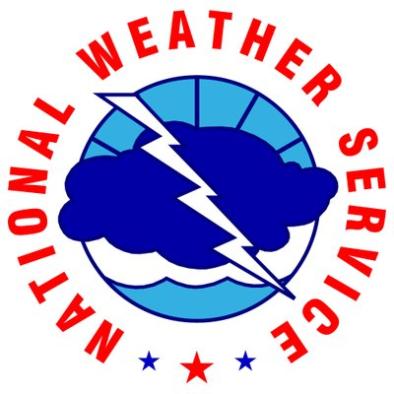
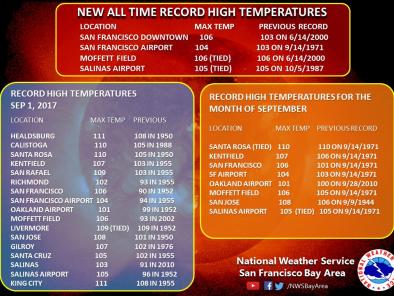

Climate science at a glance
- Researchers at Lawrence Berkeley Laboratory conducted a rapid analysis of the heat wave and estimated that the human interference in the climate system made the forecasted high temperatures between 4 and 7 times more likely.
-
The fingerprint of global warming is evident in the trend of increasing extreme heat in California, according to a major study published in the Proceedings of the National Academies of Science (PNAS) in April.[1]
-
In the US, western regions set the most records for the number of heat wave events in the 2000s. Heat waves have become generally more frequent across the US in recent decades.[2]
-
There has also been a dramatic increase in nighttime temperatures in the US, reducing the number of critically important relief windows during heat waves.[2][3]
-
The kind of stalled weather pattern that intensified the heat wave in California is the sort of pattern expected due to climate change.[4]
Record setting heat waves are a clear signal of climate change
On September 1, a strong high pressure system stalled over the western US and allowed temperatures to rise to record-setting levels across much of California. Downtown San Francisco set the most prominent high, recording 106°F on September 1.[5] “This was the highest reading since records were first kept there in 1874,” said National Weather Service meteorologist Duane Dykema. “That’s the oldest climate station in California. That’s a significant record.”[5] (For a complete list of records set in the Bay Area during this heat event, click here.)
Readings also soared above 110°F across California’s Central Valley,[6] while in southern California, days of triple-digit heat helped fuel the largest wildfire on record in Los Angeles.[7]
The heat on September 1 was so intense and widespread that WU weather historian Christopher Burt stated:
[T]his is the greatest statewide heat wave ever recorded in California.[6]
According to the US National Academies of Science, the increasing frequency, intensity, and duration of heat waves is the most firmly established impact of climate change to date.[2]
Weather records tend to be broken when natural variation runs in the same direction as climate change[8] – in this case towards increasing extreme heat.
In a stable climate, the ratio of days that are record hot to days that are record cold is approximately even. However, in our warming climate, record highs have begun to outpace record lows, with the imbalance growing for the past three decades.[9]
The trend in global warming has contributed to the severity and probability of 82 percent of record-hot days globally over the 1961-2010 period.[1]
The warmer the atmosphere, the more water vapor it can hold, which increases humidity and the risk of heat related illness
The northern hemisphere has had increasingly warmer and more humid summers, and the global area covered by extreme water vapor is increasing significantly.[10] Increasing humidity is contributing to higher nighttime temperatures in the US.[11]
The fingerprint of climate change has been found in the increase of wet bulb temperature since 1973, driving heat stress globally.[12]
Higher nighttime temperatures decrease the chance of relief from the heat
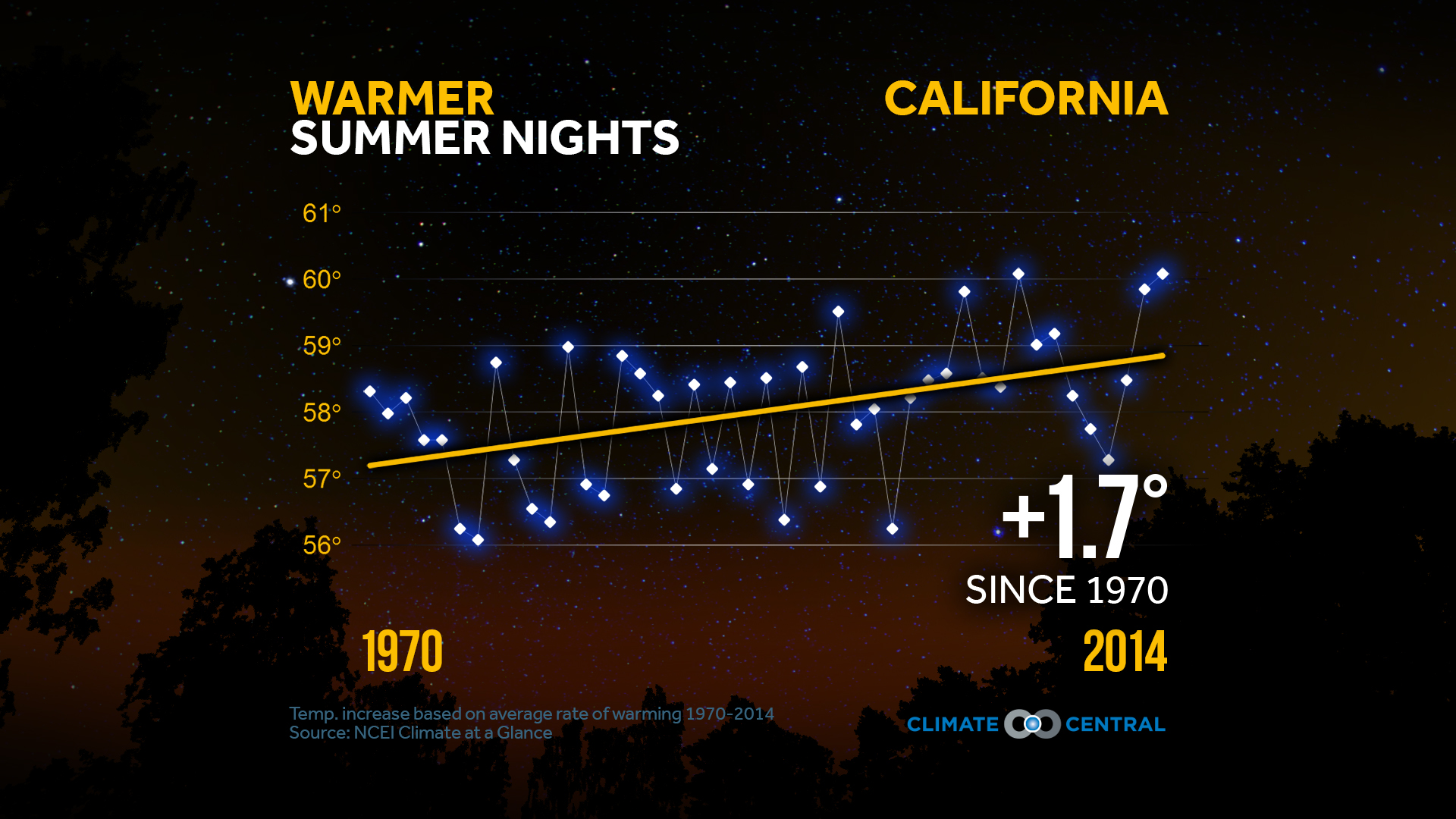 Several Bay Area cities set all-time record warm overnight low temperatures during the heat wave.[13] Downtown San Francisco tied its previous record on September 2 with a minimum tempearture of 75°F.[13]
Several Bay Area cities set all-time record warm overnight low temperatures during the heat wave.[13] Downtown San Francisco tied its previous record on September 2 with a minimum tempearture of 75°F.[13]
There has been a dramatic increase in hot nighttime temperatures in the US.[2] This means that during a heat wave, hot nights are particularly dangerous as there are no critically important relief windows for the elderly, the very young, and the ill.
The increase in hot nighttime temperatures is a signature of climate change.[14] First reported in 2005, it emerged even before the impact of global warming on hotter days.[15]
Globally, the increase in hot nighttime temperatures is linked to both increased average temperatures and the increased water carrying capacity of a warmer atmosphere, which traps heat close to the surface.[16]
Record highs are outpacing record lows
 In a stable climate, the ratio of days that are record hot to days that are record cold is approximately even. However, in our warming climate, record highs have begun to outpace record lows, with the imbalance growing for the past three decades.[9] The trend in global warming has been found to have contributed to at least 82 percent of the heat records globally over recent decades.[1]
In a stable climate, the ratio of days that are record hot to days that are record cold is approximately even. However, in our warming climate, record highs have begun to outpace record lows, with the imbalance growing for the past three decades.[9] The trend in global warming has been found to have contributed to at least 82 percent of the heat records globally over recent decades.[1]
The world is not quite at the point where every hot temperature record has a human fingerprint, but it's getting close to that.
Noah Diffenbaugh, Stanford University[1]
Climate change links to stalling weather systems
The same high pressure system that stalled over California and caused the record setting heat wave is also responsible for keeping Hurricane Harvey from moving inland.[17] This led to record breaking rainfall, with one rain gauge measuring 51.88 inches![18] (This is the single biggest rainfall measurement from a single storm in the continental US.)[18]
A study from March 2017 found that climate change is altering large-scale weather patterns, such as the jet stream.[4] These changes can dramatically amplify extreme weather events, such as extreme heat waves, during the summer.[4]
A parallel study has tentatively documented a general slowdown of atmospheric summer circulation in the mid-latitudes.[19][20] This is a consequence of the disproportionally strong warming in the Arctic; it can make weather systems move less and stay longer in a given location – which can significantly enhance the impacts of heat extremes.
Related Content
